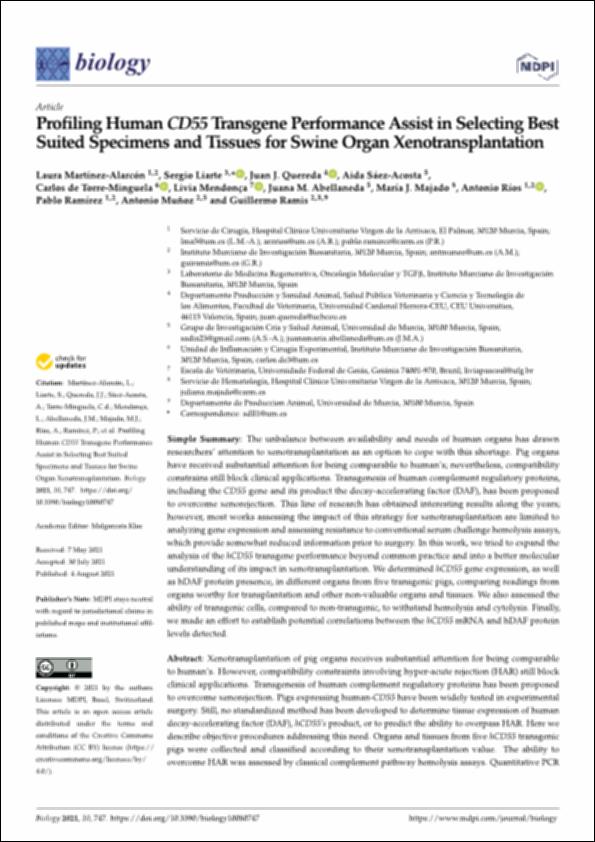Please use this identifier to cite or link to this item:
http://hdl.handle.net/10637/12997Profiling human CD55 transgene performance assist in selecting best suited specimens and tissues for swine organ xenotransplantation
| Title: | Profiling human CD55 transgene performance assist in selecting best suited specimens and tissues for swine organ xenotransplantation |
| Authors : | Martínez Alarcón, Laura Liarte Lastra, Sergio David Quereda Torres, Juan José Sáez Acosta, Aida Torre Minguela, Carlos de Mendonça, Livia |
| Keywords: | Animales transgénicos.; Xenotrasplantes.; Xenografts.; Gene expression.; Transplantation of organs, tissues, etc.; Transgenic animals.; Expresión génica.; Trasplantes (Medicina) |
| Publisher: | MDPI |
| Citation: | Martínez-Alarcón, L., Liarte, S., Quereda, J.J., Sáez-Acosta, A., Torre-Minguela, C., Mendonça, L. et al. (2021). Profiling human CD55 transgene performance assist in selecting best suited specimens and tissues for swine organ xenotransplantation. Biology, vol. 10, art. 747 (04 aug.). DOI: https://doi.org/10.3390/biology10080747 |
| Abstract: | Xenotransplantation of pig organs receives substantial attention for being comparable to human’s. However, compatibility constraints involving hyper-acute rejection (HAR) still block clinical applications. Transgenesis of human complement regulatory proteins has been proposed to overcome xenorejection. Pigs expressing human-CD55 have been widely tested in experimental surgery. Still, no standardized method has been developed to determine tissue expression of human decay-accelerating factor (DAF), hCD55’s product, or to predict the ability to overpass HAR. Here we describe objective procedures addressing this need. Organs and tissues from five hCD55 transgenic pigs were collected and classified according to their xenotransplantation value. The ability to overcome HAR was assessed by classical complement pathway hemolysis assays. Quantitative PCR mRNA expression and Western blot protein level studies were performed. Real-time cytotoxicity assays (RTCA) on fibroblast cultures exposed to baboon and human sera informed on longer-term rejection dynamics. While greater hCD55/DAF expression correlated with better performance, the results obtained varied among specimens. Interestingly, the individual with highest mRNA and protein levels showed positive feedback for hCD55 transcript after challenge with human and baboon sera. Moreover, hCD55 expression correlated to DAF levels in the liver, lung and intestine, but not in the heart. Moreover, we found significant correlations among valuable and non-valuable tissues. In sum, the methodology proposed allows us to characterize the hCD55 transgene functioning and performance. Moreover, the correlations found could allow us to predict hCD55/DAF expression in surrogate tissues, thus eliminating the need for direct biopsies, resulting in preservation of organ integrity before xenotransplantation. |
| Description: | Este artículo se encuentra disponible en la siguiente URL: https://www.mdpi.com/2079-7737/10/8/747 En esta investigación también participan: Juana M. Abellaneda, María J. Majado, Antonio Ríos, Pablo Ramírez, Antonio Muñoz y Guillermo Ramis. Este artículo pertenece a la sección "Medical biology". |
| URI: | http://hdl.handle.net/10637/12997 |
| Rights : | http://creativecommons.org/licenses/by/4.0/deed.es |
| ISSN: | 2079-7737 (Electrónico). |
| Issue Date: | 4-Aug-2021 |
| Center : | Universidad Cardenal Herrera-CEU |
| Appears in Collections: | Dpto. Producción y Sanidad Animal, Salud Pública Veterinaria y Ciencia y Tecnología de los Alimentos |
Items in DSpace are protected by copyright, with all rights reserved, unless otherwise indicated.


